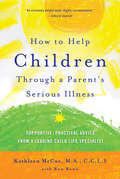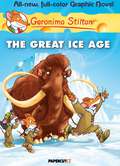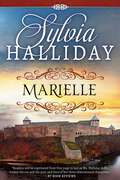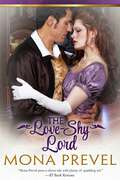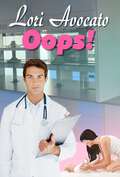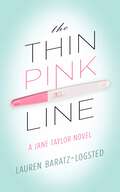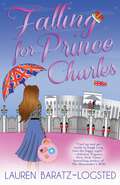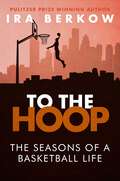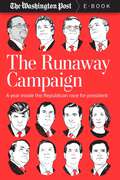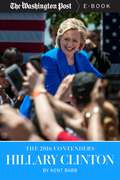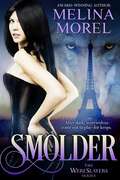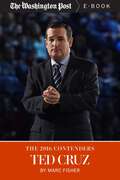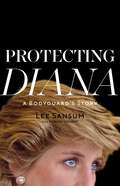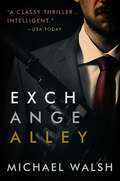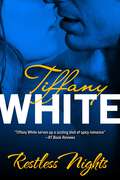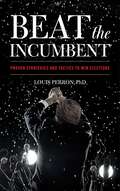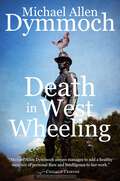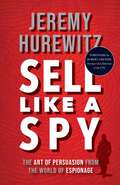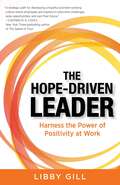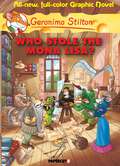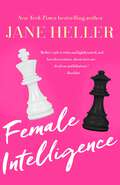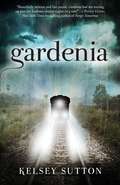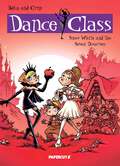- Table View
- List View
How to Help Children Through a Parent's Serious Illness: Supportive, Practical Advice from a Leading Child Life Specialist
by Kathleen McCueHow to Help Children Through a Parent's Serious Illness has become the standard work on an important subject. A classic for over fifteen years, it continues to be a go-to book for supportive, practical advice, based on the lifetime experience and clinical practice of one of America 's leading child life practitioners. Fully revised and updated, this new edition also explores the major issues and developments from the last decade that affect children today, including the dangers and opportunities of the Internet, a deeper understanding of how hereditary diseases affect children, the impact of the nation's explosive growth in single-parent families, and new insights into how family trauma and a parent's mental illness may affect children.
Geronimo Stilton Graphic Novels Vol. 5: The Great Ice Age (Geronimo Stilton Graphic Novels #5)
by Geronimo StiltonThe popular children&’s story appears in graphic novel form for the first time in the U.S., with stories never seen in America. Geronimo Stilton is a talking mouse who lives in New Mouse City on Mouse Island with his friends and relatives. He works at The Rodent&’s Gazette, the most famous newspaper in New Mouse City. In this series of comics, Geronimo Stilton travels through time in order to defend history from his arch nemeses, the Pirate Cats. These devious felines plan to travel back in time in order to change history to make them supreme rulers of Mouse Island!
Marielle: The French Maiden Series - Book One
by Sylvia Halliday"Sylvia Halliday spins a marvelous tale." —RT BOOK REVIEWS Armed only with her wavering courage and her fear that her brother has been captured during the Huguenot uprising against Louis XIII, Marielle Saint-Juste enters the Rebel prison to search him out. But it isn't her wounded brother she finds, but a mysterious stranger—and her destiny. In the darkest shadows of a French dungeon, love illuminates a brilliant path for two hearts. Marielle and Andre will face their deepest fears and trials, but their lives will be forever changed.
The Love-Shy Lord
by Mona PrevelTheir match was impossible, but their love was inevitable. Too tall for a society woman, Clarissa has no potential suitors—not that she needs any. She only has eyes for Marcus, viscount of Fairfax. But as a steward's daughter, Clarissa is hardly a suitable match for Marcus.Marcus Ridley is far too appealing—and eligible—for his own good. Restlessly pursued by desperate maidens, his view of women and marriage is skewed. But then he meets Clarissa, who steals his heart with a single kiss.Suddenly, Marcus can't get Clarissa off of his mind, and the high-society lord finds himself desperate to make the steward's daughter his wife.
Oops!
by Lori AvocatoAfter working thirteen years as a registered nurse, four of which she felt like "Hot Lips Houlihan" while serving in the United States Air Force, Lori Avocato picked up a book and said, "Hm. I can write one of these." Yeah right! Oh, she wrote several all right—seventeen to be exact—but getting them published proved to be another matter. Throughout the years, she realized it was not an easy task to write a book, much less a short, concise one. However, now as an award-winning author, Lori is multi-published with fifteen books currently sold in which her humor lends itself to her comedic voice, including the wildly popular Pauline Sokol Mysteries. She writes contemporary novels and often uses her military, medical, or a combination of both backgrounds in her plots. As an Air Force veteran, Lori belongs to RomVets and The Nathan Hale Chapter of Military Officers Association. As a writer, she belongs to The Author's Guild, Mystery Writers of America, Sisters in Crime, and Romance Writers of America along with several local chapters. Lori lives in the New England area, raising two teenage sons (Heaven help her!), and, of course, continues to write novels.
The Thin Pink Line: A Jane Taylor Novel
by Lauren Baratz-Logsted"Hilarious and original." —PUBLISHERS WEEKLY A KIRKUS starred review. Jane Taylor is a slightly sociopathic Londoner who wants marriage and a baby in the worst way, and she's willing to go to over-the-top lengths to achieve her dream. When Jane thinks she's pregnant she tells everyone. When it turns out to be a false alarm, she assumes she'll just get pregnant, no one the wiser. But when that doesn't happen, well, of course she does what no one in her right mind would do: Jane decides to fake an entire pregnancy!
Falling for Prince Charles
by Lauren Baratz-Logsted"Lauren Baratz-Logsted has mastered the real life fairy tale in her explosive and hilarious FALLING FOR PRINCE CHARLES. It's all here, lovelorn Daisy Silverman flush with cash and high hopes, Prince Charles who can't resist her, and London in all its splendor. Curl up and get ready to laugh long into the foggy night." —Adriana Trigiani, New York Times bestselling author of THE SHOEMAKER'S WIFE "Daisy's madcap adventure is more comedy than romance, and her most unusual and unlikely relationship with Prince Charles will appeal to reads looking for lots of giggles." —Publishers Weekly
To the Hoop: The Seasons of a Basketball Life
by Ira Berkow"A wonderful book—not just for basketball fans but for everyone."—Earvin "Magic" JohnsonA good reporter can pick up a pen and chronicle the game of basketball, from its X's and O's to its personalities.A great reporter can put down the pen and pick up the rock.Ira Berkow has been many things in his life—a Pulitzer Prize-winning reporter, a respected columnist, and a passionate sports fan. He also knows how to thread a pass into the paint. In this wildly entertaining chronicle of his life as both a devotee and gym rat, Berkow writes with good humor and piercing insight about talking strategy with Walt Frazier, running the court with Oscar Robertson, and seeing the game from the inside. From his youth, playing on the courts in Chicago in the &‘40's and &‘50's to growing older and using the wisdom he's gained to school players half his age, Berkow retains a competitive spirit, and a deep love of hoops. This moving tale of love for the game, for his friends and family, and for life itself is a must-read for anyone who wants the ball when the game is on the line."An extraordinary look into the art of pickup basketball. Who would have guessed that, along with his writing talents, Ira knows how to play the game!"—Bill Bradley"Ira Berkow is one of the best sportswriters around, so it is no surprise that his basketball odyssey is one of the best sports books of this or any other year."—George Plimpton
The Runaway Campaign: A Year Inside the Republican Race for President
by The Washington PostThe year 2015 will be remembered as one of the most bizarrely compelling and genuinely unnerving in the nation&’s modern political history.One contender entered the race as the scion to a political dynasty. Another entered as a reality television star. There were the religious factions, the Tea Partiers, even a moderate or two. The Republican primary quickly bloated to seventeen candidates. But where the establishment had chosen a few frontrunners behind which it would select the eventual nominee, the public and the press had other ideas. Donald Trump went from punchline to poll-leader, even as other candidates dismissed him and millions condemned his incendiary rhetoric. Now, as the primary season heats up and people start casting their votes, the field and the country wait to see whether Trump&’s populist appeal will translate to the nomination, and how the Republican party will adapt to its strange new reality. The Washington Post brings to readers the wild story of how Republicans got to where they are today, told primarily through the impressions, recollections, and analyses of those who lived it personally — the Republican candidates. This eBook is based almost entirely on on-the-record interviews with most of the major candidates — some of whom fell away — and with their advisers and other strategists. It is the story of a remarkable year in American politics.
The 2016 Contenders: Hillary Clinton
by Kent Babb The Washington PostPresidential candidates are a breed apart, often propelled by traits that have shaped their careers and have deep roots in personal histories. Often their greatest strength can turn at supernova speed into their greatest weakness. The exact qualities that set them apart from the field trip them up eventually over the long haul of a presidential campaign. Hillary Clinton&’s won&’t-back-down resolve is the quality that could make her America&’s first female president if it doesn&’t sabotage her first. She may have gotten her first campaign for the Democratic nomination wrong, but now she is doggedly determined to get it right. But that past campaign and her controversial years as first lady, while leaving her with more experience with the nuts and bolts of being president, have also left a trail of ethical questions that provide her challengers ample ammunition on the trail. In this series of eBooks, The Washington Post is exploring in-depth all these key characteristics of the leading presidential contenders, the very characteristics that could help make one of them the country&’s next commander in chief—or forever sink their presidential ambitions.
Smolder: The Wereslayers Series - Book Three
by Melina MorelCatherine Marais is the star wereslayer of the feared Institut Scientifique, frequently hunting on several continents, but the werewolves of her native France have just put out a contract on her. Now she is the prey. With the help of her partner Paul DuJardin and her vampire lover Ian Morgan, Catherine has to fight a band of increasingly motivated weres who have their sights set on her, as well as her teenage niece who&’s unknowingly fallen in love with a young werewolf. Worse than that: the boy's father is the one who ordered his pack to kill Catherine! Battling werewolves is only half the problem: her vampire lover is committed to helping protect her, and he is an enviable killing machine when confronting his enemies, but in his heart he wants Catherine with him forever. Beside her in battle and in bed, Ian never loses sight of the long game and his plan to turn the star wereslayer into his immortal beloved. PRAISE: This contemporary paranormal thriller is fast-paced from the first hunt and never slows down as the French werewolf community unites against the huntress. Filled with action and a deep look at the world of the Loup de Garous while also containing a terrific romantic subplot that enhances the prime story line, fans will appreciate the latest Catherine Marais&’ saga.&” —Harriet Klausner, Merry Genre Go Round Reviews &“[Delivers] a highly enjoyable action-oriented story with interesting, eclectic characters and a little paranormal romance. Smolder is the perfect … for readers looking to stir and warm the blood.&” —Doug Knipe, SciFiGuy.ca
The 2016 Contenders: Ted Cruz
by Marc Fisher The Washington PostPresidential candidates are a breed apart, often propelled by traits that have shaped their careers and have deep roots in personal histories. Often their greatest strength can turn at supernova speed into their greatest weakness. The exact qualities that set them apart from the field trip them up eventually over the long haul of a presidential campaign. It&’s Ted Cruz&’s ramrod devotion to principle—or, its flip side, an unyielding insistence on getting his way—that could propel him to the front ranks of Republican contenders for president or render him unelectable. In this series of eBooks, The Washington Post is exploring in-depth all these key characteristics of the leading presidential contenders, the very characteristics that could help make one of them the country&’s next commander in chief—or forever sink their presidential ambitions.
Protecting Diana : A Bodyguard's Story
by Lee SansumThis is the story of an ex-Royal Military Policeman, martial arts champion, and expert in close protection who found his way to the top of his profession, protecting the most famous woman in the world, Princess Diana. Through his assignment as protection for Mohamed and Dodi al-Fayed, he became guard and confidante to the Princess of Wales and the young princes, particularly Harry, and in Protecting Diana he details the weeks leading up to her tragic death. By chance, Sansum was not in Diana&’s car the night of the accident, but it still proved to be a turning point in his own life. His career would continue with some glamorous assignments like guarding Nicole Kidman, Tom Cruise, Pelé, and Sylvester Stallone, but his job was far from easy. He also joined the Royal Military Police, where he faced the deadly Irish Republican Army in the "Bandit Country" of South Armagh, before entering the world of private security and operating in hotspots such as Libya and Somaliland. Through protection of Princess Diana and his other high-pressure jobs where lives were at stake, Sansum provides a candid account of quiet strength, and how reading a situation is invaluable to getting out of trouble. He sets the example for achieving personal goals, overcoming trauma, and in doing so, honors one of the most outstanding figures of our age.
Exchange Alley
by Michael Walsh"JFK assassination buffs will enjoy bushwhacking their way through this labyrinthine debut…Walsh orchestrates a gripping tale of the horrors that were set in motion the day a president was murdered." —PUBLISHERS WEEKLY In this powerful debut novel Michael Walsh delivers an unparalleled jolt of dark, scintillating suspense that blends John Le Carre with James Ellroy. Lt. Francis X. Byrne, a smart, ambitious homicide detective on the rise, lives in a rundown Hell's Kitchen apartment and knows far less about his own life than he believes. Struggling with his temper, his drinking and his relationship with a woman who has him outclassed, Byrne is trying to solve the gruesome slaying of a Danish diplomat and following the trail of Egil Ekdhal's short life into a world where beautiful people play the most dangerous of games. But as Byrne gets closer to Ekdahl's true identity, he collides with the one man he loathes more than any other: his own FBI agent brother. Tom Byrne has broken every rule in pursuit of a spy's Holy Grail: the KGB's top-secret file on Lee Harvey Oswald. It's a dossier that the FBI, the CIA and even the Mafia desperately want—a file stained by blackmail, intimidation and suicide.
Ryker
by Joanne SchwehmCollege student Carrie Wallington and Marine/surfer Finn Coram battle their attraction while attempting to play by the rules.Sex, drums, and denial; three things that Ryker Jeffries excels at. Ryker buries himself in music and insignificant women, all part of his plan to keep the woman who owns his heart free from his tainted past and his darkest secret. But pretending not to want her has never been easy. Loyalty, honesty, and desire for Ryker; three things that Faith Bishop excels at. Excited about her future, Faith looks forward to finally living life on her terms. Intelligent and realistic, she knows the women who steal Ryker&’s attention are all of the things she will never be. But wanting him has never been a choice. Will he be able to resist her, or will he finally cave to his desires? Will she be able to handle his past, or will it shatter her? **Due to adult content - 18+ please** This is a standalone novel
Restless Nights
by Tiffany White"Tiffany White fans will revel in the hot, steamy love scenes." —RT Reviews To her surprise, Victoria Stone found herself with her fiancé&’s best friend, Zack DeLuca, accompanying her on holiday to a ghost town. Zack had the smoldering dark eyes of a desperado and he seemed to read her darkest desires, fuel them even. It was one thing to fantasize about a sexy gunslinger. It was quite another to have one come to life, especially when no one else could see him. Soon Victoria&’s fantasy and reality were intertwined in Restless Nights.
Beat the Incumbent: Proven Strategies and Tactics to Win Elections
by Louis PerronIncumbents enjoy many advantages when they seek reelection, but their distinct disadvantages (such as not fulfilling promises or staying within the status quo) are ripe weaknesses for opposing candidates to knock them down. Studying the US's Barack Obama, Ukraine's Volodymyr Zelensky, and France's Emmanuel Macron, among many other candidates, political strategist Louis Perron, PhD, describes tactics to assess the strength of the incumbent, the quality of the challenger, and how to control and win a campaign. Readers interested in running for office or in assisting a political campaign will learn how to build a top-notch team, define your target audience, increase your media presence, develop your message, advertise effectively, deliver great speeches, and prepare to win debates. For relatively new challengers, Perron demonstrates how lack of experience has become less important and how these weaknesses can be neutralized. When campaigns turn ugly and play dirty, he instructs candidates how to combat against character attacks and how they can make a comeback if they lose the election. With over a decade of experience orchestrating political campaigns around the globe, Perron's Beat the Incumbent is the essential step-by-step guide for any level of political office to challenge an incumbent and, once victory is claimed, how you can avoid the same traps to effect change and win reelection.
Death in West Wheeling
by Michael Allen Dymmoch&“Breakneck pace and solid atmosphere are the hallmarks here.&” —AMERICAN LIBRARY ASSOCIATION When a local schoolteacher disappears from rural West Wheeling, acting sheriff Homer Deters investigates. Before long he's got three more missing persons, two unidentified bodies, a car theft, a twenty-three-vehicle pile-up in the center of town, a missing tiger, and a squad of agitated ATF agents to deal with. With no help from the Feds, Homer turns to his buddy, Rye Willis, and West Wheeling's eccentric postmistress, Nina Ross, to locate the missing, identify the bodies, and bring a murderer to justice. Packed with regional charm and Deters&’ wit, Death in West Wheeling shows how wild one case can get.
The Braille Encyclopedia: Brief Essays on Altered Sight
by Naomi CohnAs befits this daring exploration of a life that defies clear categories and boundaries, Naomi Cohn's revelatory memoir The Braille Encyclopedia: Brief Essays on Altered Sight shapeshifts between lyric essay and prose poetry and traverses the divides between lived experience, history, and scientific knowledge. Told in the form of imagined alphabetical encyclopedia entries, this meditation on progressive vision loss examines and illuminates Cohn's at first halting then avid embrace of braille as part of relearning to read and write as an adult. Using etymology, historical and medical research, and personal vignettes, this abecedarian collection of linked micro-essays and prose poems is both Cohn's singular story of grieving and refashioning a life built around words and an evocation of the larger discussion of how our society views disability. The Braille Encyclopedia is poignant, playful, and wry, providing a literary reckoning of the technical and emotional aspects of facing the loss of sight.
Sell Like A Spy: The Art of Persuasion from the World of Espionage
by Jeremy HurewitzSecond installment of the international bestseller, The Club.With a foreword by Robert Grenier, former Director of the CIA's Counterterrorism Center, learn the art of influence from the best salespeople in the world—spies. Tapping into the history of intelligence-gathering and his work with former agents of the CIA, FBI, and other federal departments, Jeremy Hurewitz, a foremost corporate sales and security expert, offers field-tested spycraft strategies and government-agency tactics anyone can use to build relationships, persuade, and sell anything.Hurewitz has built his career around CIA case officers, FBI agents, and government officials—people like Steve Romano, former Chief Negotiator of the FBI; Mark Sullivan, former Director of the Secret Service; General Stanley McChrystal (Ret.), former Commander of the Joint Special Operations Command; and John Cipher, former member of the CIA's Senior Intelligence Service. Drawing on in-depth interviews about their skillsets, stunning spy-world anecdotes, and science-backed principles of behavioral intelligence, Hurewitz has created a handbook of lessons and techniques that will strengthen your ability to connect, entice, and make deals—in business and everyday life.Though a spy's targets may be odious—terrorists, criminals, corrupt diplomats, and more—the agent's focus is on cultivating relationships and understanding motivations to gather information, free hostages, or procure money. Elicitation, Radical Empathy, and RPM (Rationalize, Project Blame, and Minimize Fault) are just a few methods in this persuasion playbook from the real world of international espionage.With a foreword by Robert Grenier, former Director of the CIA's Counterterrorism Center, Sell Like a Spy puts James Bond in its dust, making you a true agent of persuasion.
The Hope-Driven Leader: Harness the Power of Positivity at Work
by Libby GillThe business and self-help shelves may be overflowing with success books, but author Libby Gill has found a totally fresh perspective on the topic of leadership: hope. "Libby Gill offers us a roadmap to be positive and hopeful for the future. This is a must-read for those of us ready to embrace true hope!" —Marshall Goldsmith, author of the #1 New York Times bestseller Triggers Zeroing in on what she sees as the defining issue of creating a more purposeful and productive workplace, Gill explains the science of hope theory, which is "the interconnection between beliefs and behaviors," and explores how it can shift mindsets from siloed to collaborative and productivity levels from sluggish to robust. The Hope-Driven Leader is not about feel-good theory or loaded with dry data. It's an accessible, multi-step action guide informed by the thousands of people Gill has coached in both the corporate and entrepreneurial worlds around the globe. It includes skill-building lessons based on research and illustrated by personal stories and case studies such as: • Enhancing leadership skills • Crafting a personal brand • Becoming an influencer • Managing global teams • Navigating high-impact conversations • Handling challenges specific to women leaders • And much more Whether you are a rising star or a seasoned leader in your own business, a corporation, or your community, The Hope-Driven Leader offers you a roadmap for instilling those positive beliefs and behaviors into the core of your being and the culture of your workplace. Let the journey begin! &“This is your action guide to smarter leadership, more effective teams, and bigger, better, faster results. Smart, generous, and impactful. Buy a copy for everyone on your team.&” —David Newman, CSP, author of Do It! Marketing
Geronimo Stilton Graphic Novels Vol. 6: Who Stole The Mona Lisa? (Geronimo Stilton Graphic Novels #6)
by Geronimo StiltonThe popular children&’s story appears in graphic novel form for the first time in the U.S., with stories never seen in America. Geronimo Stilton is a talking mouse who lives in New Mouse City on Mouse Island with his friends and relatives. He works at The Rodent&’s Gazette, the most famous newspaper in New Mouse City. In this series of comics, Geronimo Stilton travels through time in order to defend history from his arch nemeses, the Pirate Cats. These devious felines plan to travel back in time in order to change history to make them supreme rulers of Mouse Island!
Female Intelligence
by Jane Heller&“Hilarious.&” – USA TODAY &“Dead-on and hilarious.&”—BOOKLIST Lynn Wyman, creator and master of The Wyman Method, lives a dream life. After years of success running her own private practice that teaches men how to communicate with women, and now penning a bestseller, she's on the cusp of scoring her own TV show. It's a busy time, but thanks to her patented method, her home life is doing just fine. Kip, husband and poster child for The Wyman Method, is always sure to have dinner ready just as Lynn walks through the door. He's sensitive, thoughtful, responsible--and he's been seeing someone else. Lynn is heartbroken when she discovers him cheating, but to make matters worse, the tabloids have just found out. She's ruined. Mourning her career with her girlfriends one day, Lynn picks up the "America&’s Toughest Bosses&” issue of Fortune magazine, featuring macho bad boy CEO Brandon Brock. Struck with a brilliant scheme, she sets off to seduce this chauvinist playboy and turn him into the perfect Wyman Method success story. A simple enough task for a powerhouse like Lynn, but she hits just a few small snags. She's falling for this pigheaded patsy fast, and while she's wrestling with her emotions, a mystery person is trying to end her career.
Gardenia
by Kelsey SuttonIn this haunting young adult suspense from an award-winning author, seventeen-year-old Ivy Erickson knows the exact moment when she will die, but what she does with her remaining days could end up saving more than just her own life. "Beautifully written and fast-paced, Gardenia had me staying up past my bedtime several nights in a row!" —Pintip Dunn, New York Times bestselling author of Forget Tomorrow Ever since she was a child, Ivy has been able to see countdown clocks over everyone's heads indicating how long before they will die. She can't do anything about anyone else&’s, nor can she do anything about her own, which will hit the zero hour before she even graduates high school. A life cut short is tragic, but Ivy does her best to make the most of it. She struggles emotionally with her deep love for on-again, off-again boyfriend Myers Patripski. She struggles financially, working outside of school to help her mom and her sister. And she struggles to cope with the murder of her best friend, another life she couldn't save. Vanessa Donovan was murdered in the woods, and everyone in town believes Ivy had something to do with it. Then more girls start disappearing. Ivy tries to put her own life in order as she pieces together the truth of who ended Vanessa's. To save lives, and for her own sanity. The clock is always ticking. And Ivy's only hope is to expose the truth before it runs out completely.
Dance Class Vol. 8: Snow White and the Seven Dwarves (Dance Class Graphic Novels #8)
by BekaMary must decide how to cast the roles for the ballet Snow White, which the school will perform for International Dance Day. Bruno has no competition for the role of Prince Charming. But who will play Snow White? Julie is fed up with her perpetual image as the sweet heroine, while Carla can totally picture herself in this starring role. So who, in the end, will bite the red apple and be kissed by Bruno? Julie? Carla? Lucie? Alia? In the world of dance, anything can happen!
